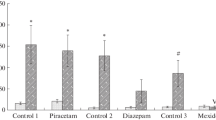Abstract
The inhibitory effects of some newly developed H1-blockers on the step-through active avoidance response in rats were studied in comparison with those of classical H1-blockers. Single administration of diphenhydramine, pyrilamine, promethazine and chlorpheniramine caused dose-related depressant effects on the active avoidance response. Ketotifen and azelastine caused less potent inhibition than the classical H1-blockers, while the effects of astemizole and oxatomide were almost negligible in suppressing the response. Following chronic administration of pyrilamine and promethazine, the acquisition of active avoidance response was significantly retarded compared with the control group, where-as new H1-blockers caused a somewhat but not significantly slower acquisition than the control group. Chronic administration of astemizole and oxatomide caused only transient suppression of the response. However, classical H1-blockers such as pyrilamine and promethazine caused sustained inhibition for as long as drug administration was continued.
Similar content being viewed by others
References
Ahn H-S, Barnett A (1986) Selective displacement of [3H] mepyramine from peripheral vs. central nervous system receptors by loratadine, a non-sedating antihistamine. Eur J Pharmacol 127:153–155
van den Brink FG, Lien EJ (1978) Competitive and noncompeutive antagonism. In: Rocha e Silva M (ed) Histamine and anti-histaminics, part II. Springer, Berlin Heidelberg New York, pp 333–367
Chand N, Harrison JE, Rooney SM, Sofia RD, Diamantis W (1985) Inhibition of passive cutaneous anaphylaxis (PCA) by azelastine: dissociation of its antiallergic activities from antihistaminic and properties. Int J Immunopharmacol 7:833–838
Douglas WW (1985) Histamine antagonists: H1- and H2-blocking agents. In: Gilman AG, Goodman LS, Rall TW, Murad F (ed) The pharmacological basis of therapeutics, 7th edn. Macmillan, New York, pp 618–628
Ganellin CR (1982) Chemistry and structure-activity relationships of drugs acting at histamine receptors. In: Ganellin CR, Parsons ME (ed) Pharmacology of histamine receptors. Wright PSG, London, pp 10–102
Holgate ST (1988) Role of histamine in allergic and atopic disease. In: Holgate ST, Goa KL (eds) Astemizole: a review of clinical experience. ADIS Press, Manchester, pp 1–8
Kaneko T, Kitahara A, Ozaki S, Takizawa K, Yamatsu K (1981) Effects of azelastine hydrochloride, a novel anti-allergic drug, on the central nervous system. Arzneimittelforschung 31:1206–1212
Laduron PM, Janssen PFM, Gommeren W, Leysen JE (1983) In vitro and in vivo binding characteristics of new long-acting histamine H1-antagonist, astemizole. In: Astemizole: a new, non-sedative, long-acting H1-antagonist. The Medicine Publishing Foundation, Symposium Series 11, Oxford, pp 11–23
Litchfield JT Jr, Wilcoxon F (1949) A simplified method of evaluating dose-effect experiments. J Pharmacol Exp Ther 96:99–113
Martin U, Römer D (1978) The pharmacological properties of a new, orally active antianaphylactic compound: ketotifen, a benzocycloheptathiophene. Arzneimittelforschung 28:770–782
McKearney JW (1982) Effects of tricyclic antidepressant and anticholinergic drugs on fixed-interval responding in the squirrel monkey. J Pharmacol Exp Ther 222:215–219
Michiels M, Woestenborghs R, Hendriks R, Heykants J, Epps J, Grindel JM (1984) Pharmacokinetics and tissue distribution of oxatomide (R 35 443) in rats and dogs. Pharmacometrics 28:357–374
Michiels M, Van Peer A, Woestenborghs R, Heykants J (1986) Pharmacokinetics and tissue distribution of astemizole in the dog. Drug Dev Res 8:53–62
Ohmori K, Ishii H, Shuto K, Nakamizo N (1983a) Pharmacological studies on oxatomide: (5) Effect on the central and peripheral nervous systems. Folia Pharmacol Japon 81:245–266
Ohmori K, Ishii H, Nito M, Shuto K, Nakamizo N (1983b) Pharmacological studies on oxatomide (KW-4354). (7) Antagonistic effects on chemical mediators. Folia Pharmacol Japon 81:399–409
Rech RH (1966) Amphetamine effects on poor performance of rats in a shuttle-box. Psychopharmacologia 9:110–117
Reuse JJ (1948) Comparisons of various histamine antagonists. Br J Pharmacol 3:174–180
Schild HO (1947) pA, a new scale for the measurement of drug antagonism. Br J Pharmacol 2:189–206
Tasaka K (1986) Anti-allergic drugs. Drugs of Today 22:101–133
Tasaka K, Kamei C, Katayama S, Kitazumi K, Akahori H, Hokonohara T (1986) Comparative study of various H1-blockers on neuropharmacological and behavioral effects including 1-(2-ethoxyethyl)-2-(4-methyl-1-homopiperazinyl) benzimidazole difumarate (KB-2413), a new antiallergic agent. Arch Int Pharmacodyn 280:275–291
Van Wauwe J, Awouters F, Niemegees CJE, Janssen F, Van Nueten JM, Janssen PAJ (1981) In vivo pharmacology of astemizole, a new type of H1-antihistaminic compound. Arch Int Pharmacodyn 251:39–51
Wauquier A, van den Broeck WAE, Awouters F, Janssen PAJ (1981) A comparison between astemizole and other antihistamines on sleep-wakefulness cycles in dogs. Neuropharmacology 20:853–859
Weidmann H, Petersen PV (1953) A new group of potent sedatives. J Pharmacol Exp Ther 108:201–206
Winter CA (1948) The potentiating effect of antihistaminic drugs upon the sedative action of barbiturates. J Pharmacol Exp Ther 94:7–11
Winter CA, Flataker L (1951) The effect of antihistaminic drugs upon the performance of trained rats. J Pharmacol Exp Ther 101:156–162
Yamada K, Ogawa N, Gomita Y, Fujiwara M, Ueki S (1973) State-dependent learning (dissociation of learning) with hallucinogens in rats. JPN J Pharmacol [Suppl] 23:66
Yamazaki N, Take Y, Nagaoka A, Nagawa Y (1984) Beneficial effect of idebenone (CV-2691) on cerebral ischemia-induced amnesia in rats. JPN J Pharmacol 36:349–356
Author information
Authors and Affiliations
Rights and permissions
About this article
Cite this article
Kamei, C., Chung, Y.H. & Tasaka, K. Influence of certain H1-blockers on the step-through active avoidance response in rats. Psychopharmacology 102, 312–318 (1990). https://doi.org/10.1007/BF02244096
Received:
Revised:
Issue Date:
DOI: https://doi.org/10.1007/BF02244096




